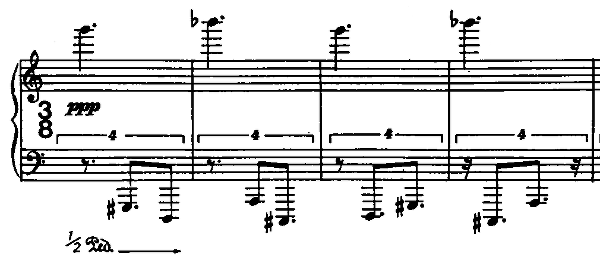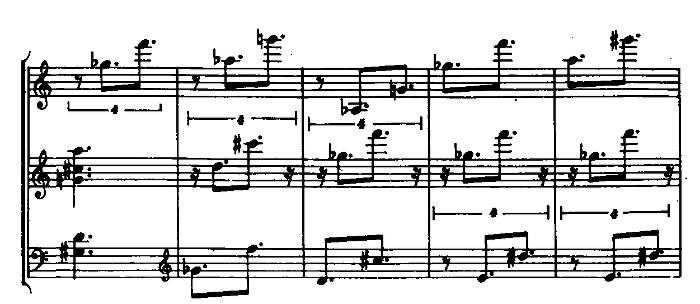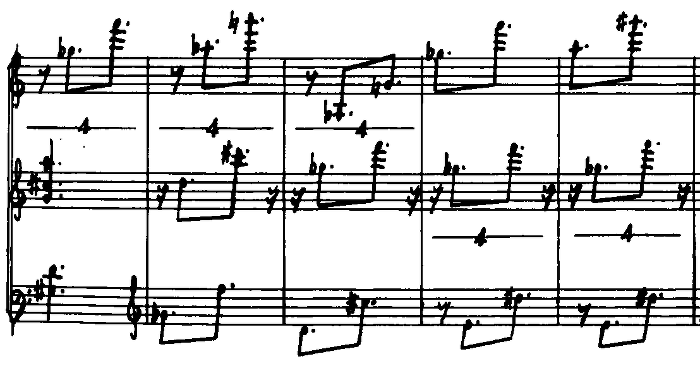
The figure above shows the opening four measures of Feldman’s Triadic memories. Almost every rhythm in the first half of the piece is present in these four bars. The time signature is 3/8, but the primary rhythmic patterns operate within a group of four eighths over that 3/8 measure. The first part of the piece is almost entirely made up of two-note phrases, and left hand in these first four measures plays the four slightly different rhythmic patterns for those phrases that dominate the first 252 measures of the piece (about twenty minutes or so at my tempo).
Starting around measure 105, Feldman creates a texture in which multiple layers of these rhythms are played simultaneously. At measure 118 he starts a passage built entirely on a particular set of three interwoven phrase patterns:

I started learning this by figuring out where the beats fell and then practicing with the metronome to get the patterns into my mind and fingers. Each measure here (after the first) has the same set of three patterns, one in 3/8 and two in 4:3. Because the two dotted eighths in 3/8 just bisect the measures, I count this passage as four beats (in fact, despite the 3/8 meter, throughout the first part of Triadic memories I feel the pulse in four). Here’s the result (with apologies for my currently out-of-tune piano):
As you can see and hear, there are two notes in each measure that occur simultaneously (e.g., the F of the bottom line and the C-sharp of the middle line in the second measure).
But as I started on this passage, something didn’t sound right to me. There was something a bit square about the rhythm, something a bit lumpy about the texture, and those two simultaneous high F’s in the fourth measure seemed strange. I went to Aki Takahashi’s recording of the piece to hear what it sounded like in her performance, and I found something surprising:
In Takahashi’s performance, none of the notes are played simultaneously: the ones that are aligned in the score are played slightly apart.
The score examples I’ve shown so far are from the typeset score, but as I described in my previous post, I use the manuscript facsimile edition, and it turns out that this helps to understand this passage and why Takahashi plays it the way she does. Here’s how that same passage looks in the manuscript score:

The note durations are all the same, but Feldman has quite clearly written them so that the alignment matches the way that Takahashi plays them. That F and C-sharp, for example, aren’t aligned, but rather the F appears slightly before the C-sharp.
I play from this manuscript facsimile score, but that subtle difference in vertical alignment went right by me. If I noticed it at all, I probably just attributed it to a slip in Feldman’s copying. But going back and looking at it, it’s clearly not a matter of a bit of a sloppy manuscript. The rhythmic pattern of this measure appear many times in Triadic memories (108 times, to be exact), and Feldman notates them with exactly the same alignment every time.
I asked Aki about this issue and got this response:
Thank you for your patience! The reason for this delay in answering is just I first wanted to check your question on my own score which I had to look for in the shelves imagining there might be some comments or anything about it. There was no comment there. So, I guess I did it that way from the visual reason and also by logical(?) reason to show the three different voices clearly! If we play this section only mathematically, then, in the 4th measure for example, how should we play the two high F notes? Anyway, I’d played this piece many times before Morton who coached me first and then he heard me play in concerts in various occasions.
Aki and Roger Woodward are the joint dedicatees of Triadic memories. I listened to Woodward’s recording and, sure enough, he plays this rhythm the same way, with no notes sounding simultaneously. I then checked out more recent recordings by Louis Goldstein, Markus Hinterhauser, Sabine Liebner, and Marilyn Nonken. All of them play this pattern with the notes aligned, not separate.
So who’s right here? The “misaligned” version of Takahashi and Woodward clearly goes against the strict interpretation of the rhythms notated, but is supported by Feldman’s manuscript and by his supervision of their performances. To my mind, it also makes more musical sense, and that’s the primary reason I’ve chosen to play it that way (although my reverence for Aki Takahashi’s playing influences me as well). That said, I can’t fault other pianists for playing the notation as written.
Whatever position one takes on how to play those 108 measures, it does reveal another reason to have these manuscript facsimile editions of Feldman’s music. Takahashi and Woodward certainly played from manuscript facsimile scores (nothing else existed at the time of their premieres). I have no idea which version of the score the other pianists used, but my hunch is that most or all of them worked from typeset scores. Did the score shape their performance choices? It seems quite likely to me. But beyond this, without the manuscript we would completely miss the possibility of Feldman intending his notation to be read in this way. Here a question about performance practice is clarified by the original hand-written copy of the score.

Hi, again. I asked the same questions, and could not figure out why the performances differed so much. Looking at the autograph for the first time, it could be that the lowest stave is still under the 4-tuplet. If the second dotted quaver were followed by a quaver rest, it would all line up as separate notes. Separate notes sound much better than the aligned version. But I do feel frustrated that MF wasn’t clear, and that the expert performers haven’t clarified. Tom
Pingback: The joy of good writing – Experimental Music Catalogue
although i’m a huge Feldman fan, the notation here is a good example of a certain pretentiousness in his approach to notation. why is this passage, clearly sounding in duple time, written in triple time? for no good reason that i can see except to make it look ‘interesting’.
I don’t think that it’s there to make it look interesting, but rather to shape the way the pianist feels the music. He saw his patterns as “notational images” and said: “A tumbling of sorts happens in midair between their translation from the page and their execution.” Having played these pieces, I can say that the use of meter and rhythm in these pieces makes you concentrate in a particular way and serves to make the music “float” a bit.